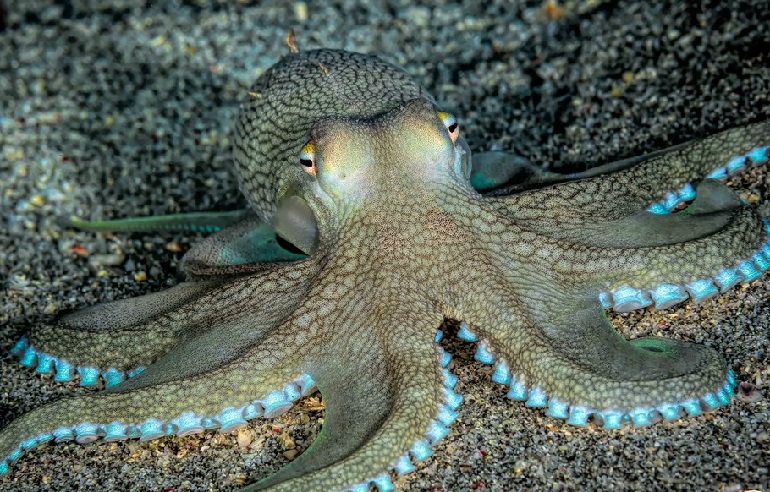Most people know that octopuses have eight legs or arms. But did you know that these alien-looking creatures have nine brains? It’s little wonder these animals are so intelligent!
Octopuses have inspired movies, featured in popular songs, and appeared in legends, and in 2010, an octopus named Paul was asked to predict the result of World Cup football matches! Despite its notoriety, octopus appears in various forms as a popular dish on restaurant menus around the world.
Octopuses have been around since the Jurassic period over 200 million years ago. Today, there are around 300 species of octopuses living in every ocean on the planet, some inhabiting shallow tidal pools and others hanging out at the bottom of the deep ocean.
Read this guide to learn more about the remarkable octopus!
Etymology
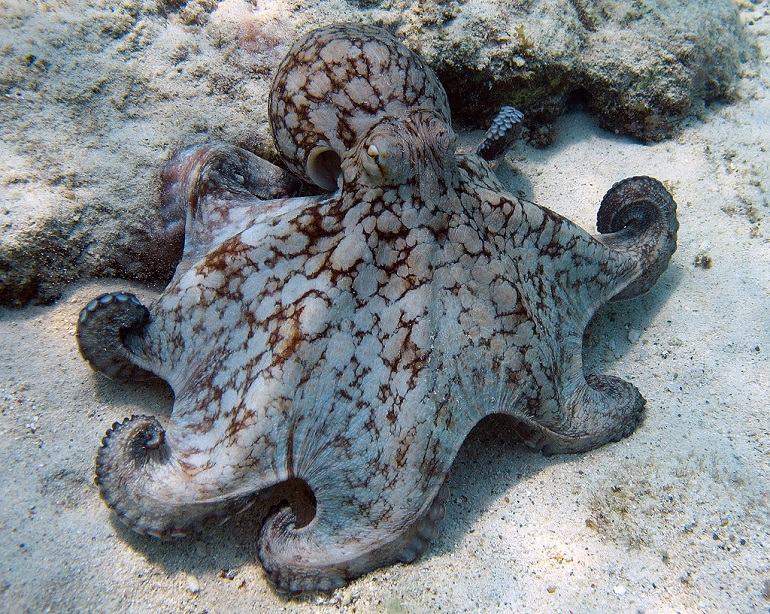
Octopus is undoubtedly a strange word, but where did it come from? It’s thought that octopus is a Latin version of the Greek word októpus, which translated means “eight-foot.”
There’s much debate around the correct plural of octopus. So, let’s bust a few common myths!
Octopi is the oldest plural for octopus, originating from the belief that the word comes from Latin origins. However, that’s incorrect. Since octopus is actually derived from Greek, the plural should be Octopodes.
But although that’s technically correct, the word octopodes is almost never used.
The correct plural of octopus is octopuses since that ending matches the English adoption of the word, which is commonly used today.
So, now you know!
Taxonomy
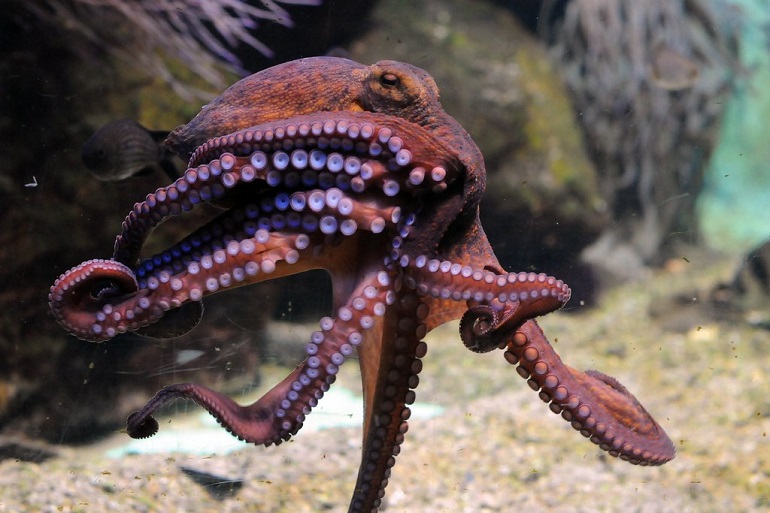
The Octopus is a mollusk that belongs to the order Octopoda. Within that order are around 289 species that sit within the class Cephalopoda, along with cuttlefish, nautiloids, and squids.
Octopuses belong to the Kingdom Animalia, just like you and I!
Evolution
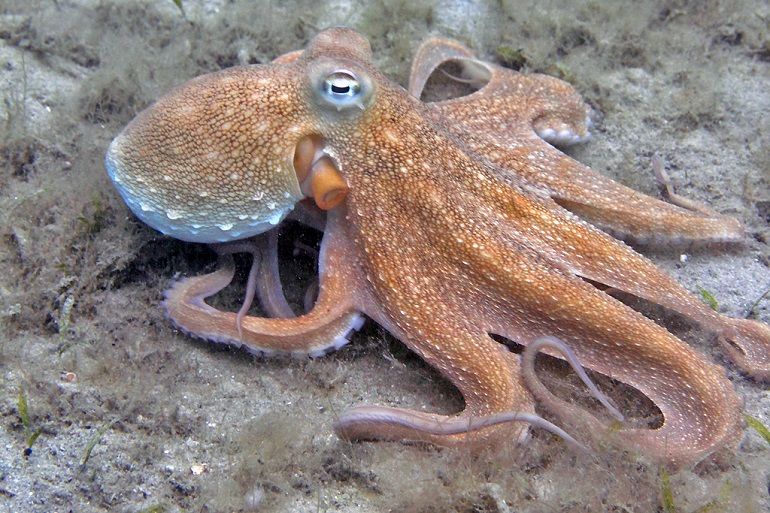
Octopuses evolved back in the Cambrian period, some 530 million years ago, from a primitive mollusk. Coleoidea diverged from the nautiloids around 416 million years ago during the Devonian period.
Octopuses and squids further evolved by bringing their shells inside their bodies. Then, 276 million years ago, the two species split again into the Vampyropoda and Decabrachia groups.
Octopuses came from primitive creatures within the Vampyropoda in the Jurassic period and lived on the ocean floor in shallow environments.
Unfortunately, since octopuses comprise mainly soft tissue, fossils are rare.
Physical Appearance
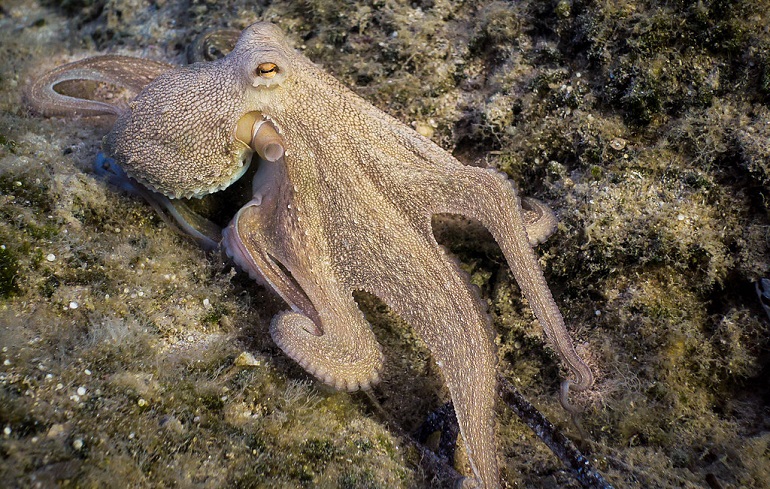
Octopuses belong to the class Cephalopoda, meaning “head foot” in Greek. In this class of creatures, the feet and head merge to form one animal.
Octopus Anatomy
The octopus has a ring of eight arms of equal length surrounding a head, which contains the animal’s mouth and brain. The underside of the creature’s arms is covered with suckers sensitive to taste and touch.
The octopus uses its two rear arms to walk on the sea floor, while the other six are used for foraging for food—the animal’s arms trail behind it when the octopus is swimming.
The creature’s sack-like body sits on top of the head and has two sensitive, complex eyes, while the octopus’s mouth is underneath. Octopuses have a hard beak that the animal uses to break into the shells of crustaceans.
Octopus Size
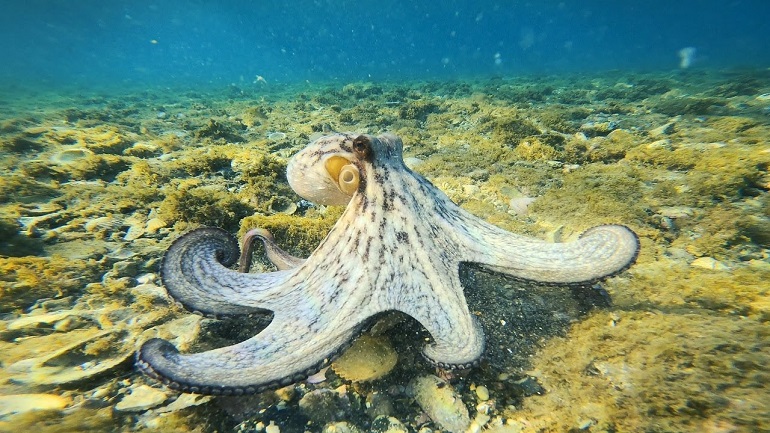
Octopuses range in size tremendously.
For example, the Giant Pacific Octopus, Enteroctopus dofleini, found off the US Pacific coast from California to Alaska, is the largest octopus in the world, having an arm span of up to 14 feet and weighing up to 33 pounds!
There are many fishermen’s tales surrounding the Giant Pacific Octopus, leading to some popular myths and legends about the creature’s size. For example, one recorded specimen had an arm span of 30 feet and weighed an impressive 600 pounds!
In contrast, the smallest octopus in the world is the Wolfi Octopus, having only a 1-inch arm span and weighing just 1 gram!
External Characteristics
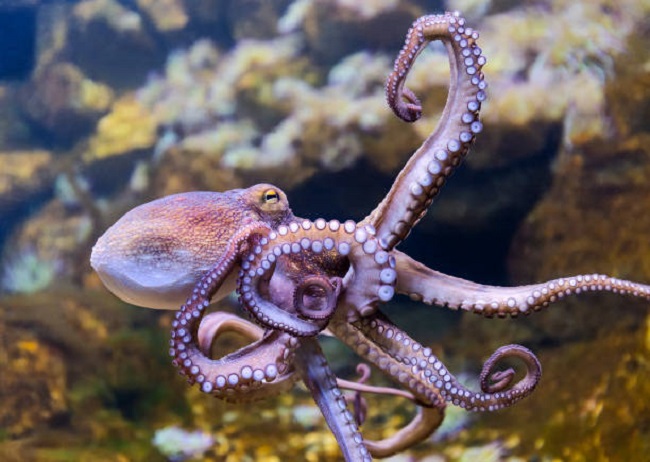
Octopuses are solitary animals that are experts in concealment and camouflage. Since the octopus has no skeleton, its body is made of around 90 percent muscle, allowing the creature to squeeze into tiny spaces where it can hide.
In addition, the octopus’ skin contains chromatophores, cells that enable the animal to change color and pattern to match its surroundings perfectly.
Physiology
Keep reading to learn more about Octopus vulgaris physiology.
Brain Power – Does an Octopus Have More Than One Brain?
The octopus has a central, donut-shaped brain located between its eyes, surrounding the animal’s esophagus. So, when the octopus swallows something, the food passes through the center of its brain!
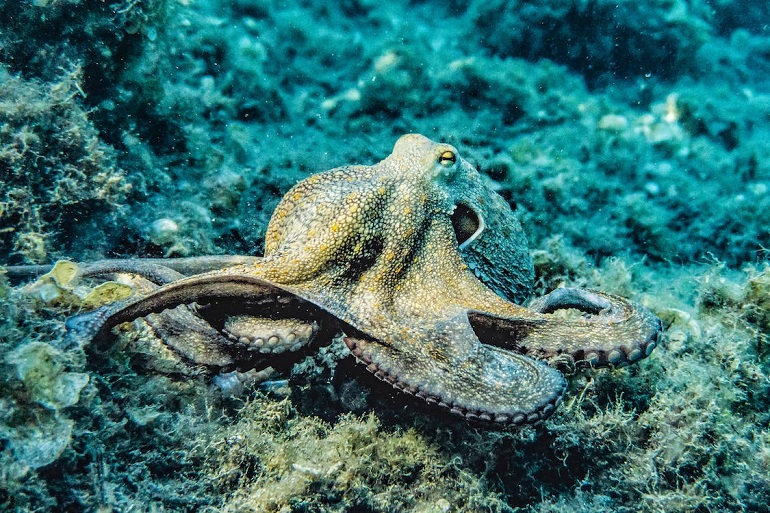
But did you know that the octopus also has eight separate mini-brains? Well, these remarkable animals have an extra brain at the base of each of their arms and a highly complex nervous system.
Each arm has its own cluster of neurons, or ganglia, meaning that each arm can act independently of the octopus’ other arms and central brain.
The neurons at the base of the arm connect to roughly 250 octopus suckers on its underside. In turn, each sucker has roughly 10,000 neurons, providing the octopus with taste, smell, and touch sensations.
Octopuses have three hearts, two of which move blood to the animal’s gills, while the third supplies the remainder of the creature’s body with blood.
Octopuses have blue blood. That’s not because the creatures are members of the aristocracy but because Octopus blood is copper-based rather than iron-based like ours. Copper-based blood contains a protein called hemocyanin, which is an evolutionary feature that makes transporting oxygen at low temperatures much more efficient.
Respiratory System
As it swims, the Octopus draws in water and oxygen into its mantle cavity via an aperture before propelling itself forward by expelling water from the siphon.
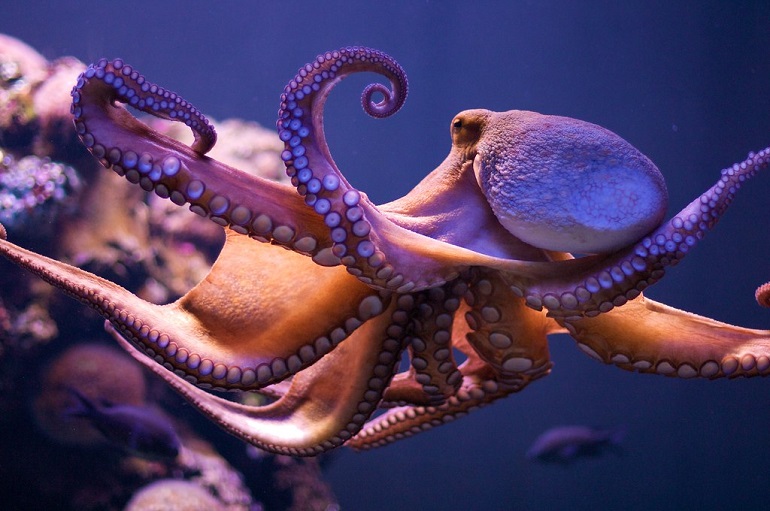
The octopus’ thin skin also absorbs oxygen. In fact, while resting, around 41% of the creature’s oxygen absorption occurs via the animals’ skin, decreasing to 33% when it swims.
Digestion and Excretion
The octopus uses a structure called the interbrachial web for gathering food. This umbrella-like structure extends between the animal’s arms, forming a bag-like container that holds prey, such as shrimp, crabs, fish, and even birds, close to the octopus’ mouth.
The mouth has two pairs of salivary glands, two in front and two in the rear. The posterior salivary glands produce cephalotoxin, which is used to kill prey. Once the toxin disables the prey, the octopus uses its suckers to dismember the unfortunate victim.
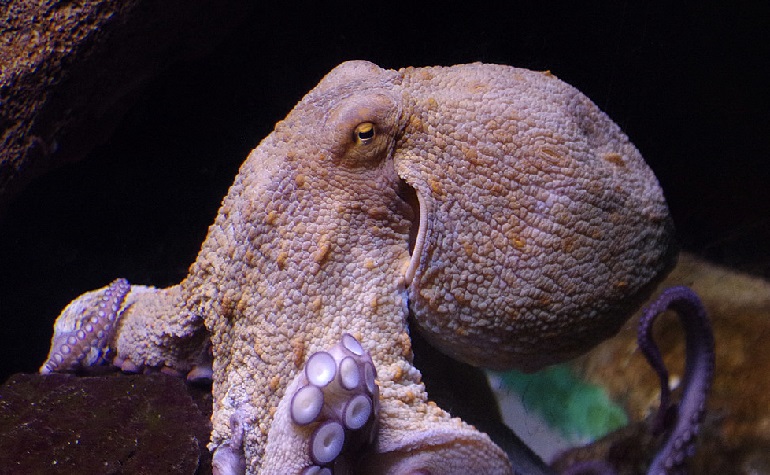
The Octopus’ parrot-like beak is made from chitinous material, just like your fingernails, only much harder. The mouth contains a tongue or radular that’s lined with tiny, sharp teeth that regrow as they wear out.
The radular works in tandem with the beak and enzymes produced by the front anterior salivary gland to break down the food into a jelly-like substance that the octopus can digest.
Once swallowed, the food passes along the esophagus into a structure called a crop. When the animal’s stomach is empty, the food moves into it from the crop, where it’s digested.
The stomach has only one tube leading in and out, meaning that any waste material must be evacuated via the same tube before more food is introduced. The waste moves from the stomach into the animal’s intestine, which moves it along until the waste reaches the end of the intestine at the siphon entrance.
The waste, or poop, is ejected from the funnel in a slender ribbon.
Ink Sac
The Octopus has an ink sac located underneath the digestive gland. A gland produces ink, and the sac stores it.
When a predator or overcurious human diver threatens the octopus, the animal shoots the thickened ink out through its funnel with a water jet. The ink contains melanin, which is what makes the ink black.
Reproduction and Lifecycle
Octopuses are solitary creatures with a very short lifespan, spending their youth eating and growing until they reach sexual maturity.
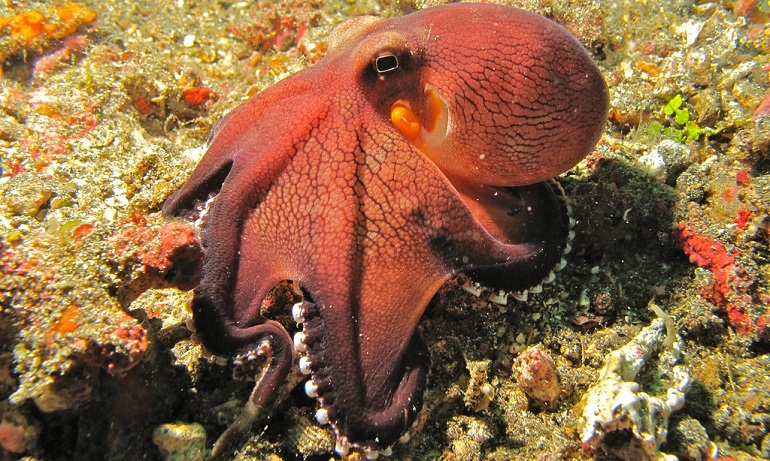
Since octopus mating is seldom witnessed and has been little studied, it’s difficult to say how males and females get together to do the deed. However, it’s thought that females attract males by sending chemical signals through the vast ocean, while males do most of the searching.
Courtship rituals vary between species. For example, a male Common Octopus rears up to show off large suckers on the underside of their arms while spreading out to appear larger and changing color.
Other octopus species, such as the Male Day Octopuses, tower over their potential mates, flashing a pattern of black stripes to impress.
Dangerous Games!
Mating can be dangerous for male octopuses since females have a habit of eating them!
Male octopuses have a mating arm called a hectocotylus with a sperm groove running down it and a specialized tip. That enables the male to mate from a distance, giving them extra time to make a dash for safety if their date turns violent.
During mating, the male inserts his hectocotylus into the female’s mantle cavity, where he deposits packets of sperm or spermatophores in a process lasting several hours, depending on the species.
The female octopus stores the spermatophores until she’s ready to lay her eggs.
The male octopus usually dies within a few months of mating, while females guard the eggs until they hatch, dying shortly afterward. That sounds somewhat drastic, but the brooding process can take up to 4.5 years in one deep-sea species.
Exception To The Rule
In one recently discovered octopus type, mating happens sucker-to-sucker, mouth-to-mouth. Fortunately, cannibalism isn’t practiced by the females of this species, and they often lay multiple clutches of eggs before finally dying.
Amazing Facts About Octopuses
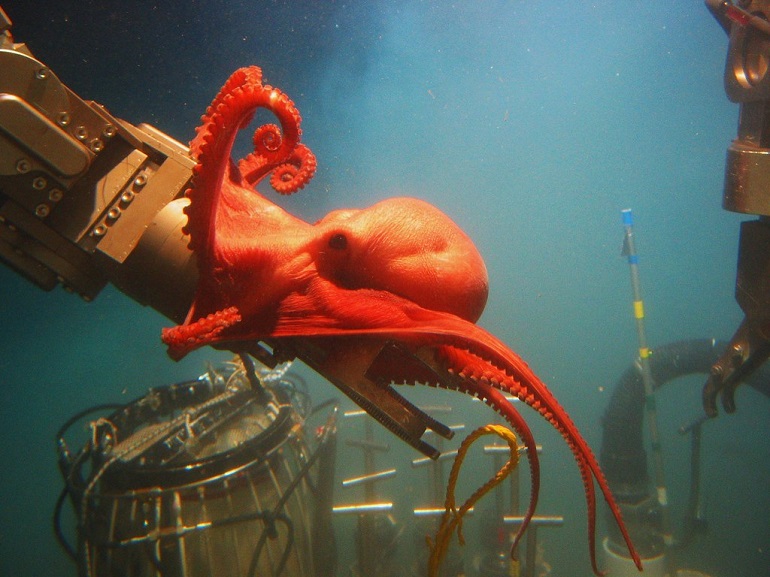
Octopuses are undoubtedly remarkable animals that never cease to amaze me. Here are a few amazing facts about octopuses that you might not know already.
Octopuses Can Use Tools
In the invertebrate world, only a few insects and Octopuses can use tools.
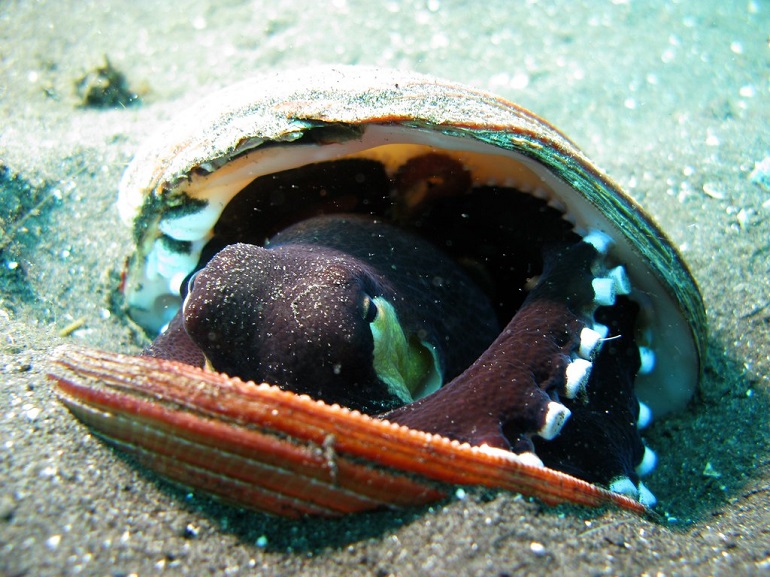
Wild octopuses have been seen to collect all kinds of objects, including bottle caps, stones, and broken shells, using the items to create barriers to their dens or for shelter.
Tremoctopus violaceus, for example, carries tentacles from the Portuguese Man o’ War for use as weapons. The tentacles contain a painful venom to which the octopus is immune but works on would-be predators and prey.
In another example of tool use, Amphioctopus marginatus was seen gathering coconut shells from the seabed, cleaning them with water jets, and assembling them as a shelter in a new location.
Octopuses Can Recognize People
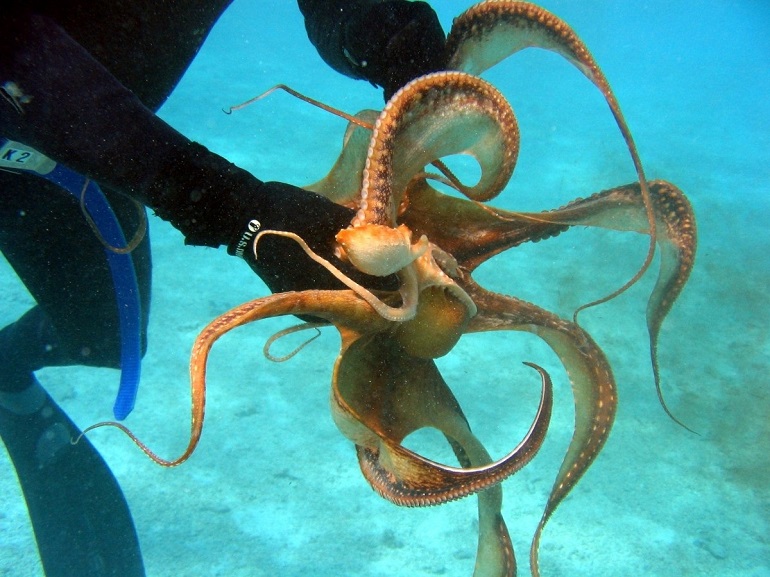
Octopuses have big eyes and excellent vision. In fact, the creatures can recognize individuals, including humans!
Don’t upset an octopus! At the University of Otago in New Zealand, a captive octopus disliked a particular member of staff, and each time that person passed his tank, the creature squirted water at her!
Octopuses Are Architects
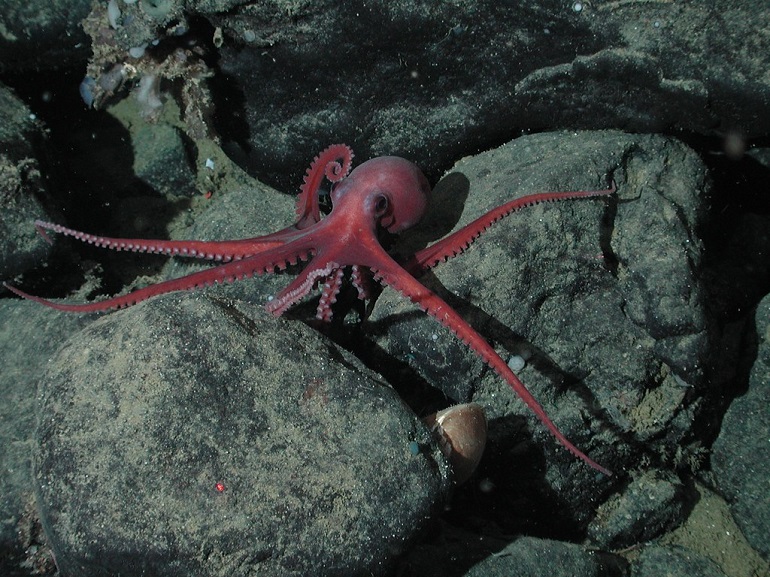
As previously mentioned, octopuses are typically antisocial and solitary creatures, only coming together to mate.
However, in 2012, researchers in Jervis Bay, Australia, discovered that the Gloomy Octopus or Octopus tetricus constructs large underwater towns. The cities or Octopolis, as scientists dubbed the constructions, are made from rocky outcrops and piles of scallops and clam shells the octopuses had previously eaten.
It’s estimated that around 15 octopuses were living in Octopolis at the time. But urban living presents many disadvantages, such as aggression and evictions! The benefits of living in a crowded settlement are unclear, although an octopus city might be the only practical option in such a barren area.
Octopuses Are Escape Artists
All octopus species are notorious escape artists, requiring modified tanks to keep them safely confined. A tank with any kind of opening or internal vents won’t keep the creatures contained for long. Octopuses can even open tank lids that are not securely fastened from the outside!
Researchers tell many stories about octopuses that have slipped their tanks and invaded neighboring aquariums to feed on the fish inside.
Octopuses Are Thieves!
Although octopuses are preyed upon by many vertebrates, including humans, the opportunist mollusks sometimes turn the tables by stealing fish and crustaceans from fishing nets and lobster pots.
Octopuses Can Regrow Severed Limbs
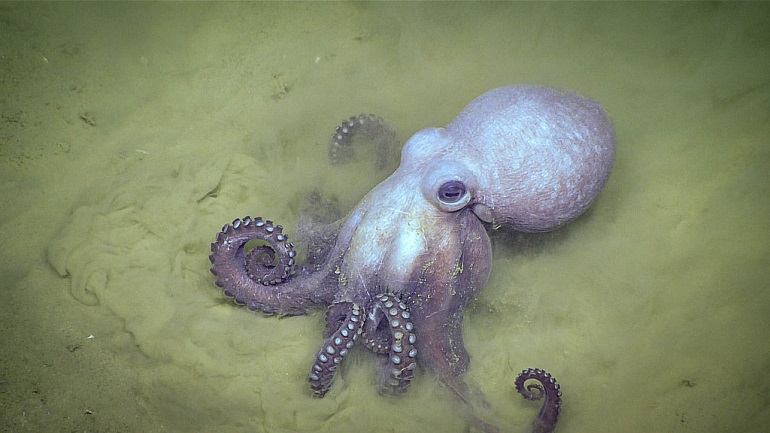
Octopus vulgaris and other cephalopod mollusks are well-known for their ability to regenerate arms and other critical body parts, including their peripheral and central nerve cords.
That’s a handy trick if the octopus loses an arm during an attack by a predator or gets caught in a fishing net when the animal sheds its arm to escape.
Octopuses Are Extremely Intelligent Creatures
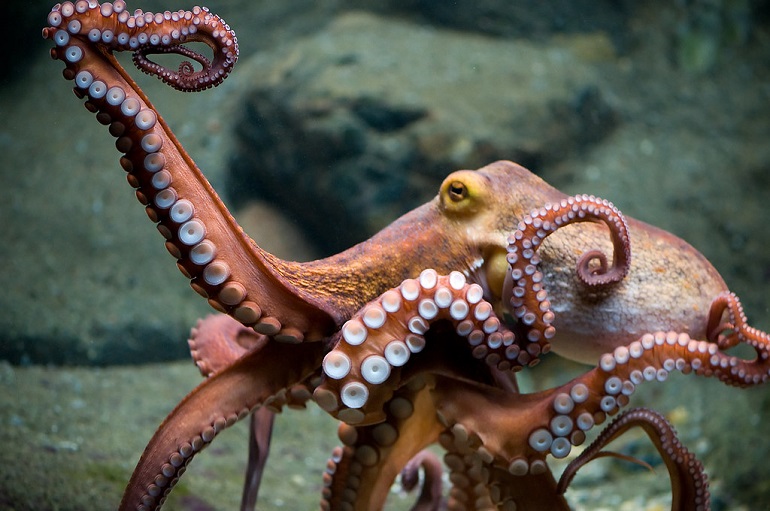
Octopuses are known for being high-intelligence animals that possess remarkable problem-solving skills.
The creatures have amazed scientists by being able to solve complex puzzles during experiments.
Where Do Octopuses Live?
You’ll find octopuses in every ocean and in varied habitats, ranging from shallow tidal pools to coral reefs and deep-water habitats.
Some species are specially adapted to live in the frigid deep ocean, such as the Spoon-armed octopus that inhabits depths of around 3,000 feet. Some species, including the Dumbo octopus, have been photographed surviving at an abyssal depth of 22,825 feet.
There are no known freshwater octopus species.
Octopus Lifespan
For such intelligent, highly developed animals, the octopus has a remarkably short lifespan.
Octopus life expectancy varies between species, but most captive and wild specimens typically live for between one and five years.
That short life expectancy is down to a reproductive strategy called semelparity, where the creature only breeds once in its lifetime before dying shortly afterward.
Behavior and Ecology
Feeding
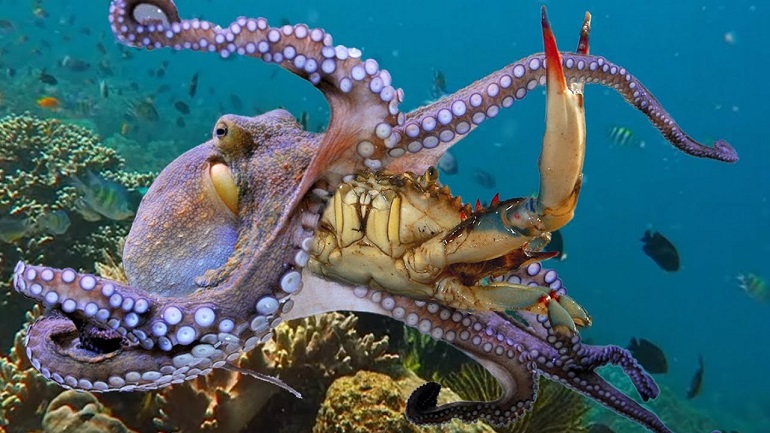
Octopuses are opportunistic carnivores and predatory hunters, using camouflage or hiding to stalk their prey. As adults, most octopuses feed on clams, crabs, small fish, snails, sea snakes, and even other octopuses.
Juvenile octopuses eat smaller foods, including larval crabs, copepods, and sea stars.
Most octopuses are nocturnal, spending the night hunting or foraging for food. However, a few species are diurnal, using their exceptional camouflage abilities to remain hidden from predators and prey alike
Defense
The Octopus has several highly-effective defense mechanisms that it uses against predators.
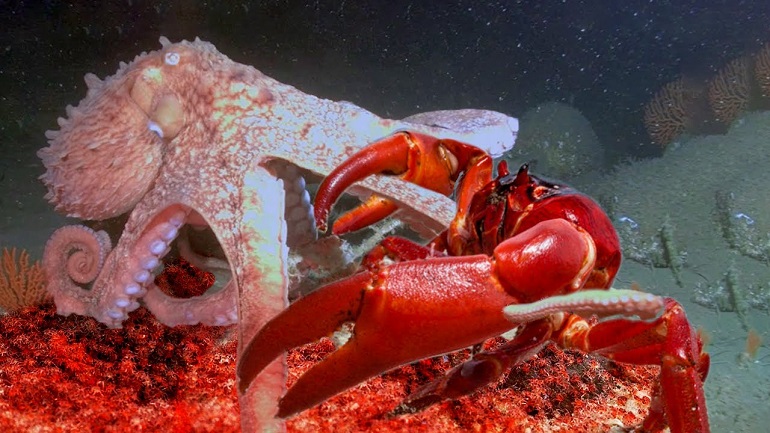
Flight
As mentioned earlier in this article, octopuses move by drawing water into their body through a siphon, propelling themselves forward by expelling the water in the same way. That enables the animal to produce a sudden burst of speed to evade a pursuer effectively.
In fact, an octopus could outswim Olympic and world record holder Michael Phelps! Using jet propulsion, octopuses can reach up to 25 miles per hour, as can other cephalopods like squid.
Hiding
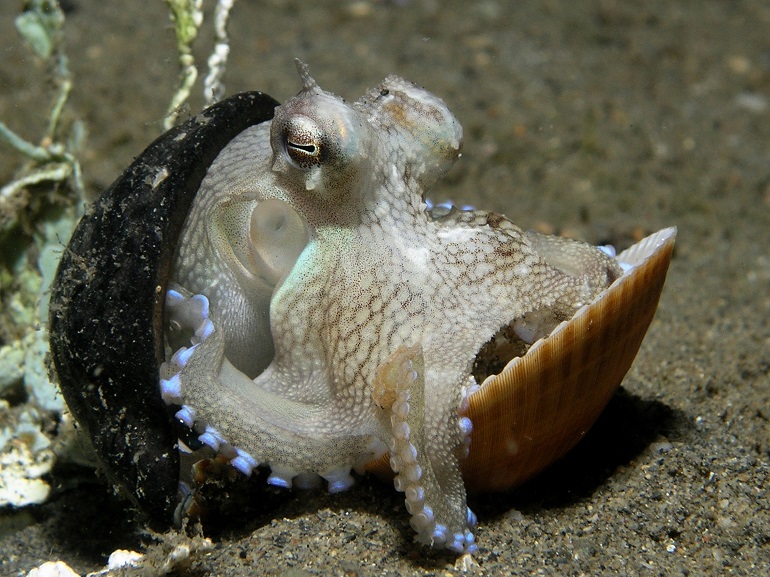
Octopuses have boneless, flexible bodies that they can cram into tiny nooks, crannies, and even empty bottles to hide and escape a potential predator. Even the most dextrous predators often can’t reach down into narrow rocky crevices to fish out an escaped octopus.
Camouflage
Most octopus species are masters of disguise, hiding in plain sight when hunting and escaping from predators if they’re caught out in the open.
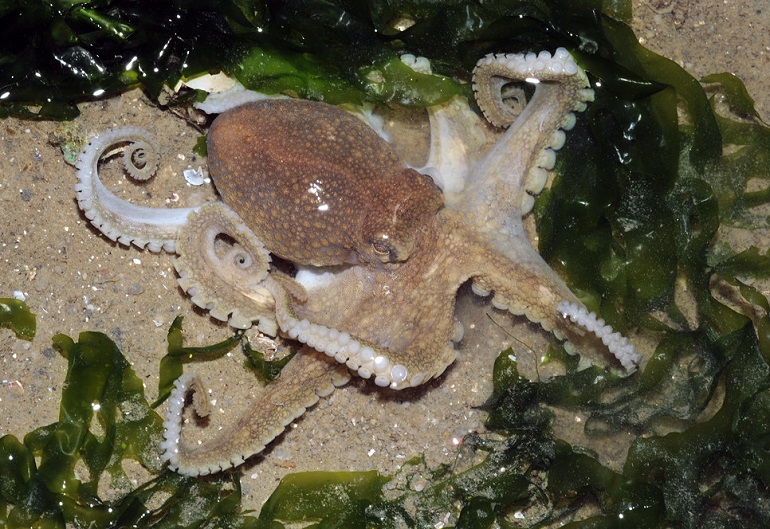
Some octopuses can even change their skin texture to blend seamlessly into corals, sponges, and rocks, while others use color to frighten away predators, such as the Blue-Ringed octopus that uses its bright blue markings to warn other animals of its toxicity.
Ink
Just like the Aston Martin car in the James Bond movie, Octopussy, the Octopus can release a dense black cloud into the water, allowing the creature to make good its escape under the cover of inky darkness.
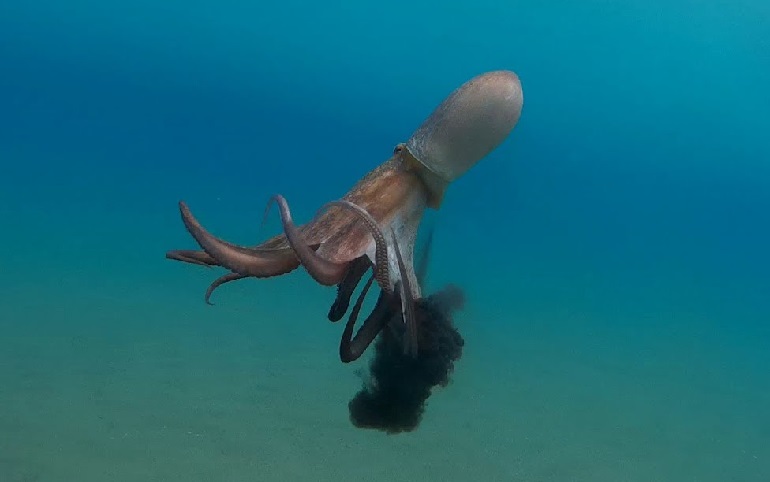
The ink also confuses and disorients the predator, affecting the senses of smell and vision long enough to give the octopus time to escape.
Pathogens and Parasites
Common protozoan parasites that are known to infect Octopuses include:
- Ancistrocomidae ciliates, skin, and gill parasites
- Opalinopsidae ciliates, attacking the renal appendages of the Octopus
- Opalinopsis parasite, attacking the liver and intestine of several Octopus species
All coleoid cephalopods can suffer from skin ulcers, bacterial infections, and attacks by parasites and protozoa. Even tiny crustaceans can take up residence in the Octopus’ mantel, gills, and skin.
Interaction with Humans
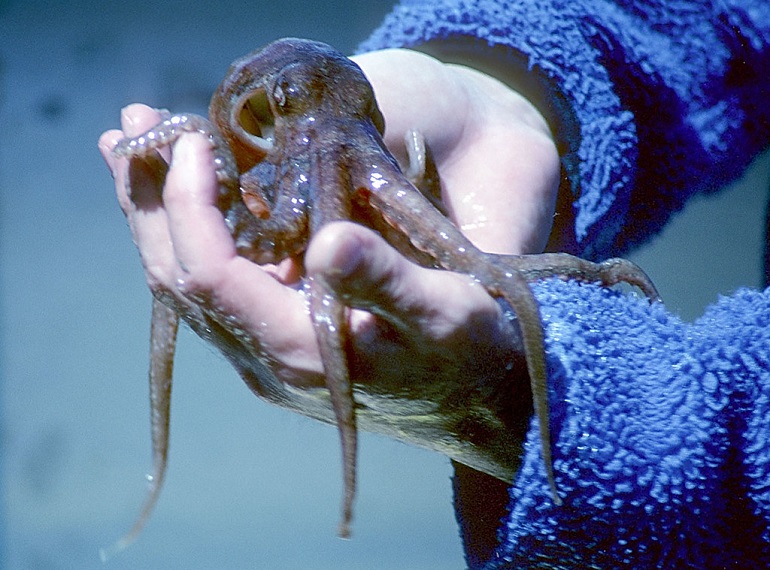
Octopuses can make interesting, entertaining pets. However, the animals have a reputation as being highly individualistic, requiring plenty of mental and physical stimulation to keep them happy and stress-free.
But don’t be deceived. The friendly octopus can be extremely choosy about who it socializes with, soaking some people while inviting physical contact with others.
Danger
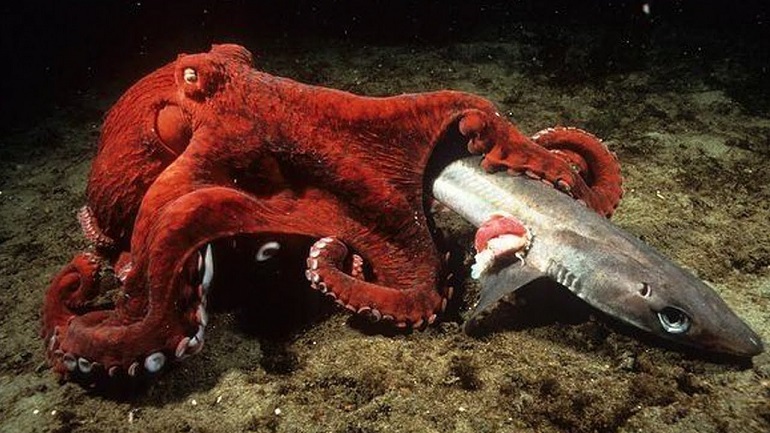
While most species of octopus can secrete venom to disable their prey, only a few species can deliver a painful bite when stepped on or interfered with by humans.
However, one species of octopus can deliver a toxin that’s fatal to humans. Hapalochlaena lunulata, the Greater Blue-ringed Octopus, is found in the waters around Australia, Indonesia, the Soloman Islands, the Philippines, Vanuatu, Papua New Guinea, and even Japan.
Thanks to the high levels of Tetrodotoxin (TTX), a potent neurotoxin, Hapalochlaena lunulata is regarded as one of the most venomous marine creatures in the world.
You don’t want to handle one of these critters since the venom can penetrate human skin without a puncture. Once in your bloodstream, TTX blocks nerve impulses to the muscles, causing paralysis. The victim’s lungs stop working, eventually leading to brain death.
There’s no known antidote to TTX, but if the victim can be treated and hospitalized quickly enough, patients often recover.
In Fisheries
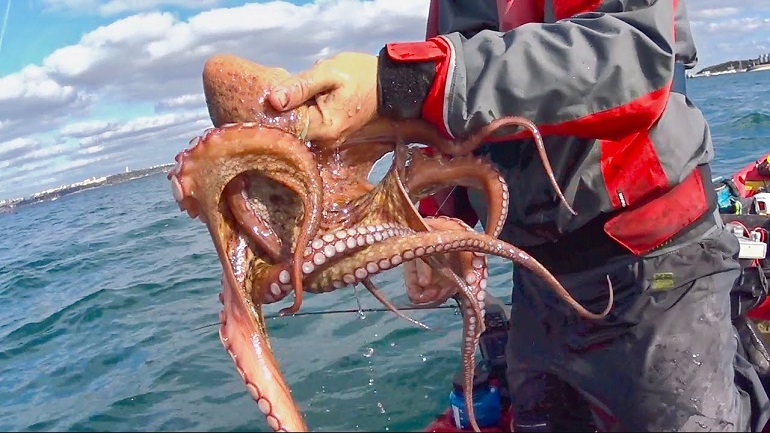
Octopuses are eaten in many cultures around the world, especially in the Mediterranean and Asian coastal areas. Consequently, there are many octopus fisheries around the world, with thousands of tons of octopus being taken annually.
Fishing methods include using pots, snares, traps, drift fishing, hooking, trawls, and collection by hand.
In Cookery
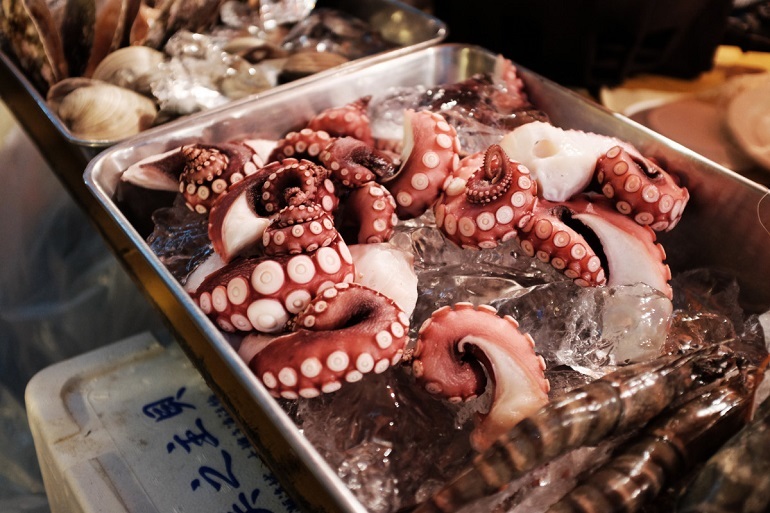
Octopus can be prepared for the plate in many ways, depending on its location and the species of octopus on the menu.
My first experience of eating octopus came in the late 1970s when I was a child. I was on vacation in the Greek Islands with my parents, and I recall that chunks of arms of octopus were served as a starter course one night in our hotel.
In some countries, including parts of the US, octopus is eaten live. I could never condone that, and I agree with other animal welfare groups that the practice is inhumane.
In Science and Technology
The humble octopus offers many opportunities for research, including the ability to regrow severed arms, change its skin color, and behave intelligently. Scientists also use the 168 types of protocadherins the octopus possesses, compared with the 58 in the human brain.
Researchers have sequenced the California Two-spot octopus’ genome, enabling its molecular adaptations to be studied.
Research into robotics also benefits from studying the octopus’ arms, which can move independently of the animal’s central nervous system. And in 2017, a pneumatically controlled silicone arm was fitted with rows of suckers that could grasp items, including a ball, a magazine, and a metal tube.
In Culture
In modern culture, the octopus appears everywhere, in art, movies, poetry, and songs.
The same is true in history, with ancient seafarers illustrating octopuses in artwork and design, such as a Bronze Age representation of a fisherman carrying an octopus discovered in Knossos, Crete.
However, the most famous legends involve the Kraken, a mythical giant cephalopod sea monster of Scandinavian folklore. The Kraken lives in the deep waters of Norway and Greenland, periodically rearing out of the water to sink ships and attack their crew.
But in Japan, the Red octopus is regarded as lucky; its movement is associated with grace, flexibility, agility, and a feeling of calmness. Tell that to those Scandinavian sailors of old who might disagree!
Final Thoughts
I hope you enjoyed our guide to the amazing octopus!
Octopus are found in every ocean on the planet in habitats ranging from shallow, tidal pools to coral reefs and even the deep, abyssal ocean.
These remarkably intelligent creatures can recognize people and solve simple puzzles, and their escaping abilities rival those of Houdini! Of the 300 or so species of octopus, the Blue-Ringed Octopus is highly venomous, and a bite from this critter could kill you.
However, most species are benign, even friendly animals that can make entertaining pets. Did you ever encounter an Octopus while swimming, or do you keep one in an aquarium as a pet?
Tell us about your cephalopod experiences in the comments box below, and don’t forget to share the article before you go!


